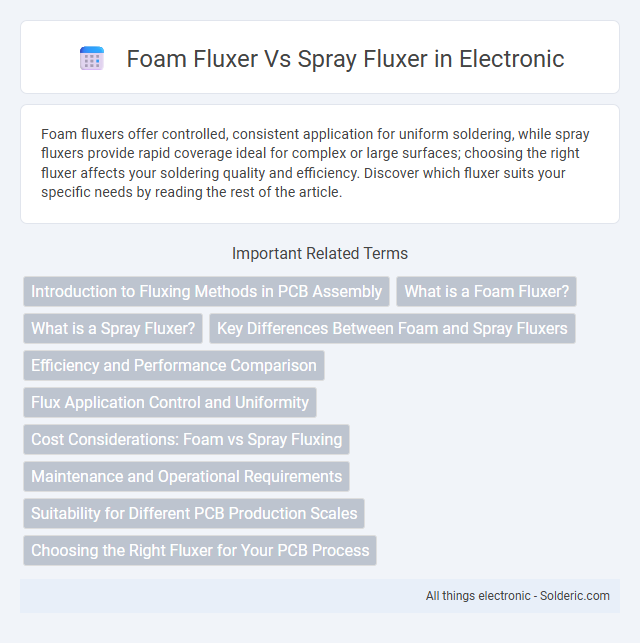Foam fluxers offer controlled, consistent application for uniform soldering, while spray fluxers provide rapid coverage ideal for complex or large surfaces; choosing the right fluxer affects your soldering quality and efficiency. Discover which fluxer suits your specific needs by reading the rest of the article.
Comparison Table
| Feature | Foam Fluxer | Spray Fluxer |
|---|---|---|
| Application Method | Applies flux via foam pad, ensuring controlled coverage | Sprays flux in a fine mist for uniform application |
| Flux Coverage | Localized and focused coverage | Wide and even coverage |
| Flux Consumption | Lower flux consumption due to precise application | Higher flux usage due to spray dispersion |
| Best Use Cases | Small to medium PCB assemblies, targeted fluxing | Large surface PCBs, mass production environments |
| Equipment Cost | Typically lower initial investment | Higher equipment and maintenance cost |
| Maintenance | Simple cleaning and replacement of foam pads | Requires regular nozzle cleaning to prevent clogging |
| Flux Type Compatibility | Works well with no-clean, rosin, and water-soluble fluxes | Compatible with a broad range of flux types including water-based |
Introduction to Fluxing Methods in PCB Assembly
Foam fluxer and spray fluxer are two essential methods in PCB assembly for applying flux, which improves soldering quality by removing oxides and promoting wetting. Foam fluxing involves immersing the PCB edge in flux foam, ensuring controlled and uniform application primarily on through-hole components, while spray fluxing dispenses flux as a fine mist, ideal for surface-mount devices with precise coverage requirements. Selecting between foam fluxer and spray fluxer impacts flux volume, distribution consistency, and process efficiency critical for high-reliability electronic manufacturing.
What is a Foam Fluxer?
A foam fluxer is a specialized soldering tool designed to apply flux in a foamed form, enhancing the activation and cleaning of metal surfaces before soldering. It produces a consistent, controlled foam layer that improves flux coverage and reduces oxidation, ensuring better solder joint reliability. Foam fluxers are particularly effective for delicate electronics and precision soldering tasks where uniform flux application is critical.
What is a Spray Fluxer?
A Spray Fluxer is a device designed to apply flux evenly across printed circuit boards (PCBs) using a fine spray, enhancing solder joint quality by preventing oxidation and improving solder flow. Compared to a Foam Fluxer, which uses a foam applicator for coating, the Spray Fluxer offers more precise control over flux volume and distribution, reducing waste and ensuring consistent coverage. Your PCB assembly process benefits from the Spray Fluxer's ability to deliver a uniform, controlled flux layer ideal for high-volume or complex soldering applications.
Key Differences Between Foam and Spray Fluxers
Foam fluxers deliver flux in a thick, dense foam form, enabling precise application and minimizing waste, while spray fluxers distribute flux as a fine mist for faster coverage over larger surfaces. Foam fluxers provide better control and reduced flux consumption ideal for delicate, small-scale soldering tasks, whereas spray fluxers enhance efficiency in high-volume or large-area soldering processes. The choice between foam and spray fluxers depends on the required application precision, flux usage efficiency, and production volume demands.
Efficiency and Performance Comparison
Foam fluxers deliver consistent coverage by applying flux as a uniform foam layer, which minimizes overspray and reduces waste, enhancing overall efficiency in soldering processes. Spray fluxers offer faster application over larger surface areas but may lead to uneven flux distribution and increased material consumption, potentially impacting performance quality. Evaluations show foam fluxers achieve higher precision and material savings, while spray fluxers excel in speed, making the choice dependent on the specific manufacturing requirements.
Flux Application Control and Uniformity
Foam fluxers provide superior flux application control by delivering a consistent foam layer that reduces flux waste and ensures uniform coverage across printed circuit board surfaces. Spray fluxers, while able to cover larger areas quickly, may cause uneven flux distribution due to droplet size variability and overspray, leading to inconsistent solder joint quality. Precise flux volume regulation in foam fluxing enhances repeatability and process reliability, critical for high-density PCB assembly requiring strict flux uniformity.
Cost Considerations: Foam vs Spray Fluxing
Foam fluxers generally offer lower initial equipment costs and reduced flux consumption due to precise application, making them cost-effective for medium to high-volume soldering processes. Spray fluxers tend to have higher maintenance expenses and increased flux usage from overspray, which can elevate operational costs over time. Your choice between foam and spray fluxing should factor in long-term cost efficiency, considering flux wastage, maintenance, and production scale.
Maintenance and Operational Requirements
Foam fluxers require regular cleaning of the foam generation system to prevent clogging and maintain consistent flux application, with frequent checks on air pressure and foam stability essential for optimal performance. Spray fluxers demand routine inspection and cleaning of nozzles to avoid blockages caused by flux residue, as well as maintaining pump and filtration systems to ensure uniform spray patterns. Both systems benefit from scheduled calibration and monitoring to minimize downtime and maximize operational efficiency in soldering processes.
Suitability for Different PCB Production Scales
Foam fluxers are ideal for small to medium PCB production scales, offering precise flux application and minimizing waste. Spray fluxers suit large-scale manufacturing due to their ability to cover extensive surface areas quickly, enhancing throughput. You should select a fluxing method based on production volume and process efficiency requirements.
Choosing the Right Fluxer for Your PCB Process
Selecting the right fluxer for your PCB process depends on the type of soldering and board sensitivity involved; foam fluxers apply flux by immersing the board edge in a foam, ideal for wave soldering with consistent, controlled flux deposition. Spray fluxers use nozzles to atomize and evenly distribute flux, offering superior control for selective soldering and fine-pitch components. You should evaluate flux application precision, cleaning compatibility, and production speed to optimize solder joint quality and efficiency.
Foam fluxer vs spray fluxer Infographic

 solderic.com
solderic.com